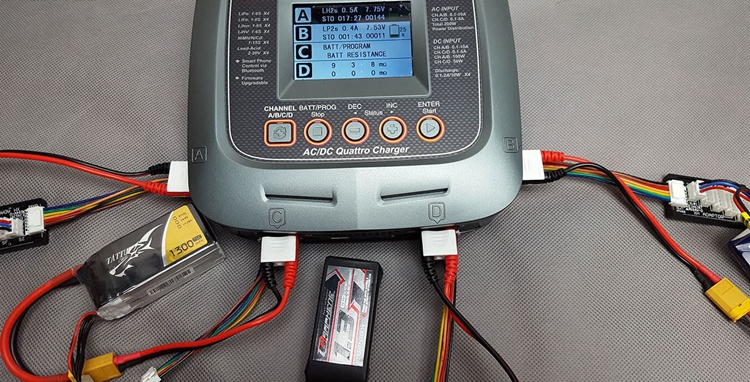LiPo Battery Charging/Discharging & Safety Information
12/01/2019 09:43
Connection: You must be sure that the correct polarity is observed when connecting battery packs to the charger or speed controller.
PINK / RED = POSITIVE (+)
BLUE / BLACK = NEGATIVE (-)
LiPo Battery Charging:
Lithium Polymer batteries have specific charging requirements and ONLY chargers rated for Lithium Polymer cells may be used. The best chargers are those which require the user to manually select cell count and charge rate for each pack of cells, then automatically check to see that the settings are correct. The Hyperion EOS Charger line belongs to this category. Chargers which use only automatic detection of cell count (and on that basis set charge voltage) are prone to error and can damage cells or cause a fire due to over-voltage charging of cells. We recommend that these chargers be set manually if used. Other chargers are set manually but do not include a safety circuit to oversee that setting. These are prone to user error, and should also be checked very carefully to ensure proper use.
Lithium CC/CV chargers, like those in the Hyperion EOS Charger line, must be used. These charges initially at a constant 4.2V and constant 1C rate, then taper the charge rate as the battery nears full capacity. Cells are about 90% charged in one hour and can be left connected for another 20-30 minutes to complete the charge. The maximum permissible charge voltage per cell is 4.2V. The maximum recommended charge rate for Lithium Polymer cells is 1C (ex: 1.5A for a 1500mAh pack). Please do not charge your lithium polymer at any rate higher than 1C. Doing so may reduce the capacity and life cycle of the cells, with very little savings in charge time.
Discharging: Any battery including lithium polymer must be discharged within rated current and voltage limits. Failure to do so will result in damage to the battery, at least, and could even cause an accident.
Use a motor speed controller which has auto-cut feature for lithium polymer. Auto-cut should be set at 3.0V per cell. A three-cell pack, therefore, should be set for 9.0V auto-cut, for example.
Don’t leave the battery pack plugged into the vehicle while not in use. The pack can still discharge to an unsafe level and damage the pack even if all components are turned off.

Make sure to cycle your packs at least once per month since leaving them on the shelf for a prolonged period can cause the packs to get severely out of balance or even go dead.
Do not exceed the manufacturer's rated maximum continuous discharge rating!
USE AN AMPMETER, like An Eagle Tree Data Logger, to confirm the maximum amperage drawn by your motor-batter-propeller combination
Do NOT count on "unloading" during the flight to greatly reduce the current drawn. In most cases this effect is MINIMAL. In the case of High pitch props at high RPM, the in-flight amperage may actually RISE substantially. Factor this into your calculations.
Taps on Lithium Polymer Packs:
All MaxAmps Lipo packs come standard with Hyperion/Apache style balancing taps (white connector). This tap can be used with the MaxAmps Method Balancer, Hyperion LBA10 Balancer and also with the Apache 505 Balancer. Always balance your pack before each use to prevent the possibility of over-charging or over-discharging. This also “matches” the voltage of each cell to give you the highest performance and longest life. (We can do the 4 main balance tap types on any pack)
Lithium Polymer Safety Tips:
Lithium Polymer cells are a tremendous advance in battery technology for RC use. However, due to the chemistry of lithium cells, there is a possibility of fire if charging is not properly done. It is unavoidable due to the nature of lithium itself. This is no different from many things we use in daily life – knives, kitchen cleaners, automobiles, for a few examples – which are inherently dangerous, but which can be used safely by adhering to simple rules and precautions.
Be absolutely sure that the Lithium Polymer charger settings are correct for the battery pack being charged – both voltage and current settings
Lithium Polymer must be CHARGED and STORED in a fire-safe container like a Lipo Sack
Do not charge batteries near flammable items or liquids
Keep a dry fire extinguisher nearby - or a large bucket of dry sand, which is a cheap and effective extinguisher
Never charge inside an automobile even when parked
Batteries should NEVER be left unattended while charging
KEEP BATTERIES AWAY from children and pets at ALL times
Handling Cautions: New cells may have a high initial charge, and care must always be taken to ensure that loose cells are not short-circuited.
Never leave batteries inside a car on a hot day, nor any other place where ambient temperature may exceed 140F / 60C.
Although environmentally friendly, lithium polymer cells must be FULLY discharged before disposal. Use a resistor setup (light bulbs, for example) to accomplish this, to avoid the possibility of a short-induced fire after disposal.
Immediately discharge damaged batteries at 1/2 C-rate and dispose of.
Do not put the loose cells in a pocket, bag, or drawer where they could short-circuit against other items, or the battery tabs could be pressed against each other.
Do not place the loose cells on any conductive surface, such as a metal-topped table.
We recommend purchasing pre-assembled packs rather than assembling packs from loose cells.
Take care that the cells are not punctured, especially by metallic objects like hobby knives.
If the electrolyte in the cells should get on your skin, thoroughly wash with soap and water. If in the eyes, rinse thoroughly with cool water. Immediately seek medical attention for this, or for burns.
All Lithium Polymer Batteries we carry are only approved for RC use, and may not be used in any other application. Battery discharging, charging, electric motors, spinning propellers, and flying models all have the potential for serious injury to persons and damage to property. In purchasing these products, the user agrees to accept responsibility for all such risks, and not to hold the battery manufacturer, distributors, or retailers - (all including owners and employees) -responsible for any accident, injury to persons, or damage to property.
As used in radio-controlled model aircraft, discharge rates exceed the manufacturer’s specified maximum rates. Therefore, the use of Lithium Polymer batteries in radio-controlled models is to be considered experimental, and there is no warranty, expressed or implied, by the manufacturer, distributors, or retailers with respect to the capacity, life in cycles, store


 Change Warehouse
Change Warehouse













